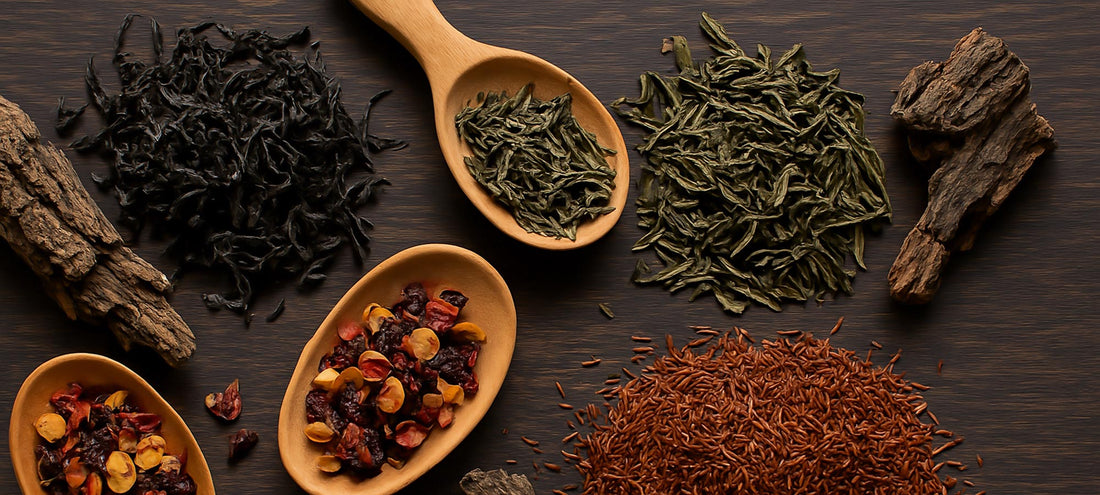
The Best Loose Leaf Tea to Buy Online: A Guide for the Curious
Share
Estimated read time: 7 minutes.
Buying tea online should feel like stepping into a quiet atelier—calm, curated, considered. Yet for many, it feels more like wading through noise. Endless claims. Cluttered pages. Bags labelled “premium” with nothing to support the name.
So where does one begin?
This is a guide not for the rushed, but for the curious. For those who want to understand what makes one tea worth sipping—and another worth skipping.
What Is Loose Leaf Tea, Really?
Loose leaf tea refers to whole or partially intact tea leaves, sold without the confinement of a tea bag. It is the form closest to the leaf’s natural state—and the one most capable of expressing flavour, aroma, texture, and time.
Unlike bagged teas, which often contain dust or fannings (the smallest, broken bits), loose leaf allows the full leaf to unfurl, breathe, and tell its story in water.
But not all loose leaf is created equal.
What Makes a Loose Leaf Tea Worth Buying?
1. Whole Leaves, Not Just Loose Leaves
Look for brands that show their tea, not just sell it. A good loose leaf should be recognisable—twisted strands, rolled pearls, broad flat leaves. If it looks like dust, it will taste like it.
Ask yourself:
- Are the leaves uniform in size?
- Can I see complexity in colour and texture?
- Does it look alive?
Great tea doesn’t hide in pouches. It’s proud of how it looks.
2. Single-Origin or Transparent Sourcing
Just as wine has terroir, so too does tea. A Darjeeling from the Himalayas is not the same as one blended from various gardens. Seek single-origin teas or blends that tell you where each component comes from. Altitude, harvest season, cultivar—these aren’t marketing terms; they’re flavour cues.
If the source isn’t mentioned, assume it’s not worth mentioning.
3. Harvest and Freshness
Tea is an agricultural product. Its vibrancy fades with time. Look for harvest dates—especially for green, white, and lightly oxidised oolongs. These are best consumed fresh, ideally within 6 to 12 months of harvest.
Black teas and aged teas (like pu-erh) follow different rules, but the principle is the same: freshness is clarity.
Where to Buy Loose Leaf Tea Online: What to Look For
Buying online should never feel like a compromise. In fact, it should offer more transparency than a shop shelf can.
Here’s what separates exceptional online tea brands from the rest:
✔ Thoughtful Product Pages
Each tea should have:
- Tasting notes: not generic (“floral”), but layered (“jasmine top note, honeyed mid-palate, dry hay finish”)
- Brewing guidance: temperature, time, and ratio tailored to the tea
- Harvest information: location, season, elevation
- Visuals: real photographs of the dry leaf, the infusion, and the liquor in cup
✔ Transparency About Quality
Does the brand explain what makes a tea “premium”? Do they talk about oxidation levels, cultivar, picking standards?
Luxury doesn’t shout. But it does show its work.
✔ Thoughtful Packaging and Shipping
Premium tea is fragile. It should arrive protected, sealed, and whole. Look for brands that use opaque, airtight containers—not thin plastic zip-locks. Bonus points for packaging designed not just to protect the tea, but to elevate the experience.
Types of Loose Leaf Tea to Explore
If you’re new to loose leaf, start with one or two categories and drink them slowly. Explore them like you would a wine region or a fragrance family.
🖤 Black Tea
Strong, layered, grounding. Look for:
- Golden Monkey (China): cocoa, stone fruit, soft spice
- Darjeeling First Flush (India): muscat grape, rose, green almond
🌿 Green Tea
Fresh, vegetal, delicate. Look for:
- Dragonwell (China): chestnut, spring grass, savoury umami
- Sencha (Japan): seaweed, citrus, steamed greens
🌸 Oolong
Between green and black. Floral, creamy, often roasted. Look for:
- Milk Oolong (Taiwan): orchid, butter, sugarcane
- Wuyi Rock Tea (China): charcoal, plum skin, mineral
🕊️ White Tea
Soft, subtle, slow. Look for:
- Silver Needle (China): melon rind, honeysuckle, linen
- White Peony (China): hay, apricot, herbal bitters
🌙 Pu-erh (Aged Tea)
Earthy, mellow, complex. Look for:
- Sheng Pu-erh (Raw): bright, grassy, evolving over years
- Shou Pu-erh (Ripe): earthy, damp wood, cocoa, loam
Signs of a Brand That Respects Its Tea
You’ll know it when you feel it. Quiet confidence. Measured words. A sense that someone has tasted and touched every leaf before offering it to you.
Look for brands that:
- Offer limited batches, not endless SKUs
- Invest in education, not just promotion
- Honour the ritual of brewing as much as the product itself
Final Thoughts
The best loose leaf tea to buy online isn’t always the most expensive, or the most ornate. It’s the one that tastes like where it came from. That’s been handled with care. That asks you, gently, to slow down.
If you’re new to this world, begin with one tea. One pot. One moment.
And if you’re ready for more—well, you’re already in the right place.




